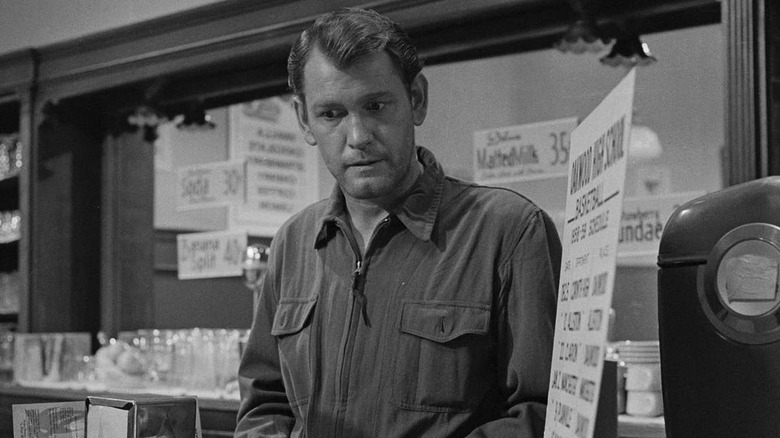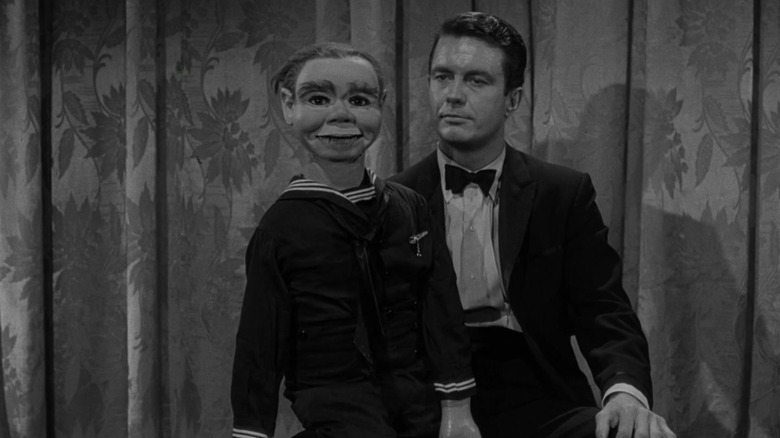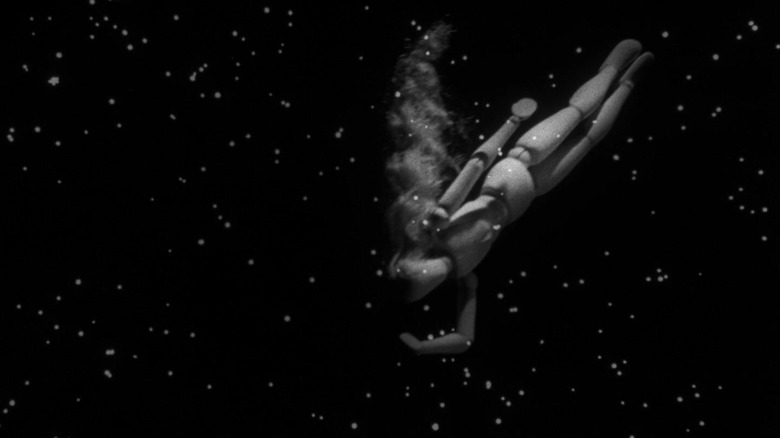The Twilight Zone Almost Had Merchandise Before The Pilot Was Even Made
The first episode of Rod Serling's anthology series "The Twilight Zone" debuted on CBS on October 2, 1959. The episode was titled "Where Is Everybody?," and it starred Earl Holliman as Mike Ferris, a man who walks into a small, suburban neighborhood that is mysteriously devoid of people. He has no memories as to how he got there or even his own identity. He explores the town and finds no people, save for one creepy mannequin. The solitude quickly causes him to deteriorate mentally. All good "Twilight Zone" fans know the twist ending that occurs next.
By the time "The Twilight Zone" premiered, Serling was already a prolific, established TV writer, having written for hit anthology shows like "Playhouse 90," and "Kraft Television Theater." He had even written the screenplays for movies like "Patterns" and "The Rack" and was always trying to push the envelope in terms of what might be allowed on television. Ultimately, Serling felt that sci-fi might be the best way to explore his interests, so he began to pen miniature morality plays in a bookended format, eventually developing them into "The Twilight Zone."
The series was an instant hit and remained on the air for five seasons. It has been adapted into a feature film and rebooted on television several times since. It also seemed destined for success from the get-go; even back in 1958, Serling was already being approached about merchandising tie-ins.
There was almost a Twilight Zone board game in 1959
As covered in Martin Gram, Jr.'s 2008 book "The Twilight Zone: Unlocking the Doors to a Television Classic," a toy manufacturer called the Boyd Specialty Company caught wind of "The Twilight Zone" and felt it was a golden opportunity. The company's president, John J. Boyd, Sr., wrote to Serling, asking if he could use the TV show's name for one of his board games and then depict the board game in several episodes as an advertising tie-in.
Board game geeks will hastily point out there was an officially licensed "Twilight Zone" board game released in 1964 (the year the show went off the air), but that game was produced by the Ideal Toy Company and, uh, it doesn't look ideal. No, Boyd's letter to Serling argued his "Twilight Zone" game was going to be the Next Big Thing, so cross-promotion was a no-brainer. As Boyd put it:
"It is more interesting than Monopoly will ever be, and you and those concerned could reap results that would be astounding as when offered for sale with your show, that we can get publicity in every science and fiction publication all over the world for free."
One can easily sense Boyd's enthusiasm. If anyone was skeptical about the potential success of "The Twilight Zone," Boyd wasn't one of them. You should also know that product tie-ins were still largely uncommon in the late 1950s, so Boyd's idea was no idle business-as-usual proposition. Be that as it may, there are no details in the letter as to what kind of gameplay Boyd's "Twilight Zone" board game would've featured, much less what its design would've been like. (Not to mention, some might scratch their heads at Boyd's "more interesting than Monopoly" descriptor, as Monopoly isn't usually a family's first choice when it comes to a board game night.)
Serling was too busy to entertain the idea of a Twilight Zone board game
Serling did write back to Boyd, explaining that it was way too early in production to consider merch tie-ins for "The Twilight Zone," adding that he, as the show's creator and head writer, wouldn't have anything to do with licensing anyway. To quote him directly:
"My job will be principally in the creation of the series and in the writing of several of the shows, and I would have little time to consider any other aspect. The gentleman you might write to is Mr. William Dozier, head of programming on the West Coast. The address is simply CBS-Television City, Hollywood, California. I hope you can work something out with him."
That seemed to be the end of the 1958 efforts to make a "Twilight Zone" board game. Boyd doesn't seem to have gone on to anything successful, and the Boyd Specialty Company doesn't appear to still be in business. The 1964 board game from Ideal doesn't have any designers credited, so it seems unlikely that Boyd had anything to do with its manufacture.
Of course, "Twilight Zone" merch would eventually begin to appear over the decades, and I say this as someone who owned a "Twilight Zone" T-shirt in the 1990s, has played the "Twilight Zone" pinball machine, and has paid admission at the "Twilight Zone" mini-golf course in Las Vegas. There have also been tie-in audio adventures (released on vinyl in the 1960s), and the series went into long-term syndication after its cancellation, ensuring that multiple generations would grow up adoring "The Twilight Zone." It's still streaming today and its Blu-rays are readily available. One can't say how successful the 1958 "Twilight Zone" board game might have been, but it would be nice to look into a parallel universe and find out.


